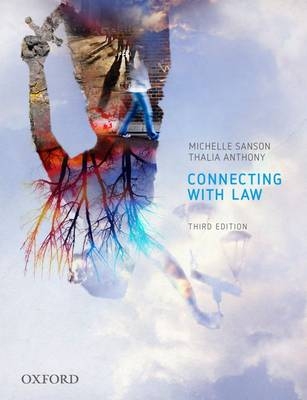
Connecting with Law
OUP Australia and New Zealand (Verlag)
978-0-19-552505-2 (ISBN)
- Titel ist leider vergriffen;
keine Neuauflage - Artikel merken
to, and which help them understand the law.
Michelle Sanson is an International Lawyer and Humanitarian and Adjunct Fellow at UWS School of Law. Thalia Anthony is a Senior Lecturer, Faculty of Law, University of Technology Sydney.
Chapter 1 - Learning Law: How Can I Develop a Legal Mind?1: Law as a discipline2: Legal reasoning3: Outcomes of your legal education4: Success in law schoolChapter 2 - Sources: What Is the Law Itself?1: Primary and secondary sources of law2: Legislation3: Cases4: Secondary sourcesChapter 3 - Legal Institutions: How Is Law Made?1: Government in Australia2: Constitutions of the Commonwealth and the states and territories3: Parliament’s role in creating law4: The executive’s role in administering law5: The judicature’s role in interpreting law6: Alternatives to courtsChapter 4 - Classifying and Practising Law: How Are Cases Resolved?1: Major legal classifications2: Branches of substantive law3: Aspects of procedural lawChapter 5 - Research: How Do I Find the Law?1: The importance of legal research2: Legal research methodology3: Using a library catalogue or search engine4: Finding legislation5: Finding cases6: Finding and using secondary sources7: Legal referencingChapter 6 - Communication: How Do I Engage with Others about the Law?1: The importance of communication2: Formulation: Preparing to communicate3: Engagement: In-person communications4: Engagement: Written communications5: Collaboration6: Review: Continual improvementChapter 7 - Jurisprudence: What Is Law?1: Introduction2: Traditional theories3: Modernism, Marxism and socio-legal theory4: Legal realism5: Critical legal theories6: Dominant jurisprudence todayChapter 8 - History: How Did Australian Law Develop?1: Legal systems of Indigenous societies and their early exclusion from the common law 2: Displacement of Indigenous laws3: Reception of English law4: Military origins of the Australian legal system5: Key concepts from English legal and constitutional history6: How English legal and constitutional history applies in Australia7: Adoption of English common law – from the frontier to the Australia Acts8: Federation and British remnants todayChapter 9 - Australia: Where Does Indigenous Law Fit In?1: Historical developments in official policies relating to Indigenous people: Exclusion and inclusion2: Recognition of Indigenous rights to land3: Developments since Mabo4: Other forms of recognition of Indigenous rights to land5: Ongoing non-recognition of customary law6: Alternative paths for incorporating customary law into the common law7: Filling the legal gap – treaty and sovereignty rightsChapter 10 - Precedent: How Do Judicial Decisions Become Law?1: Introduction to precedent2: Key concept s in the law of precedent3: Applying precedent4: Judicial approaches to precedent5: Problem solving using precedentChapter 11 - Statutory Interpretation: How Do Courts Interpret Legislation?1: Introduction to statutory interpretation2: Modern statutory approach3: Traditional common law approaches4: Other tools of statutory interpretation5: Applying the rules of statutory interpretationChapter 12 - The Profession: What Do Lawyers Do?1: Overview of Australian legal practice2: Solicitors3: Barristers4: Judges5: Some other roles in the legal profession6: Ethics7: What kinds of work do lawyers do?Chapter 13 - Law in Society: What Are the Problems and Remedies for Accessing Justice?1: Access to justice – key issues2: Access to justice for specific groups3: The role of legal aid4: Other initiatives to promote access to justiceChapter 14 - My Law Career: How Can I Best Prepare for It?1: Is law really for me? How do I know?2: What kind of career can I expect as a lawyer?3: Important choices of subjects and course structures4: What can I do as a student to become the lawyer I want to be?5: Maintaining wellbeing
| Erscheint lt. Verlag | 3.11.2014 |
|---|---|
| Verlagsort | Melbourne |
| Sprache | englisch |
| Maße | 190 x 246 mm |
| Gewicht | 1322 g |
| Themenwelt | Recht / Steuern ► Allgemeines / Lexika |
| Recht / Steuern ► EU / Internationales Recht | |
| Recht / Steuern ► Privatrecht / Bürgerliches Recht ► Berufs-/Gebührenrecht | |
| ISBN-10 | 0-19-552505-1 / 0195525051 |
| ISBN-13 | 978-0-19-552505-2 / 9780195525052 |
| Zustand | Neuware |
| Haben Sie eine Frage zum Produkt? |
aus dem Bereich


